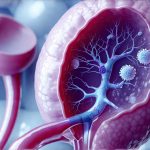Bladder inflammation, often manifesting as cystitis, is a surprisingly common condition affecting millions worldwide. While many associate it with urinary tract infections (UTIs), the reality is far more nuanced. Inflammation can stem from bacterial infection, but also from non-infectious causes like autoimmune responses, radiation therapy, certain medications, or even interstitial cystitis/bladder pain syndrome – a chronic condition with poorly understood origins. This complexity underscores the importance of accurate diagnosis and tailored treatment approaches. Simply treating every instance as a UTI can lead to antibiotic overuse and ineffective management for those suffering from non-infectious bladder inflammation. Understanding the diverse systemic pathways available is crucial for providing optimal patient care, moving beyond symptomatic relief towards addressing the underlying cause whenever possible.
The goal of systemic treatment isn’t merely to eliminate acute discomfort but to prevent recurrence and improve long-term quality of life. This requires a holistic assessment that considers individual factors like medical history, lifestyle, potential triggers, and co-existing conditions. Treatment options range from oral medications targeting inflammation or immune modulation, to more advanced therapies including immunomodulatory drugs and even experimental approaches still under investigation. It’s essential for patients to partner with healthcare professionals who can navigate these options effectively and provide informed guidance based on the latest evidence-based practices. This article will delve into some of the key systemic treatment pathways currently employed in managing bladder inflammation, emphasizing both established methods and emerging trends.
Systemic Antibiotic Therapy & Beyond
Antibiotics remain a cornerstone for treating acute bacterial cystitis, the most frequently recognized form of bladder inflammation. However, the rising prevalence of antibiotic resistance necessitates judicious use. Guidelines generally recommend short courses of antibiotics like nitrofurantoin or trimethoprim-sulfamethoxazole for uncomplicated cases. It’s vital to complete the full course even if symptoms resolve, preventing incomplete eradication and fostering resistance development. Increasingly, healthcare providers are utilizing urine cultures before prescribing antibiotics to confirm infection and identify specific antibiotic sensitivities, ensuring targeted treatment.
Beyond initial treatment, preventative strategies are crucial. For patients with recurrent UTIs (defined as two or more infections in six months or three or more within a year), low-dose prophylactic antibiotics may be considered, but again, used cautiously due to resistance concerns. Alternative preventative measures – increasing fluid intake, practicing good hygiene, avoiding irritants like caffeine and alcohol – are often recommended alongside, or even instead of, long-term antibiotic use. The focus is shifting towards minimizing antibiotic exposure while effectively managing recurrent infections. Importantly, systemic antibiotics are not effective for non-bacterial bladder inflammation; in these cases, relying on them can delay appropriate treatment and exacerbate the condition.
For patients with chronic or recurring bacterial cystitis unresponsive to standard antibiotics, more aggressive approaches may be necessary. This could involve longer antibiotic courses, alternative antibiotic regimens based on culture results, or even investigations into underlying anatomical factors contributing to infection (like bladder outlet obstruction). The use of systemic antibiotics should always be carefully monitored by a healthcare professional and tailored to the individual patient’s needs.
Immunomodulatory Approaches
When bladder inflammation arises from autoimmune processes or conditions like interstitial cystitis/bladder pain syndrome (IC/BPS), immunomodulation becomes a key treatment strategy. These approaches aim to rebalance the immune system, reducing chronic inflammation without broadly suppressing immunity. One example is pentosan polysulfate sodium (Elmiron®), an oral medication thought to restore the bladder lining by inhibiting inflammatory mediators and preventing bacteria from adhering to the bladder wall. While its exact mechanism remains debated, Elmiron has shown benefit for some IC/BPS patients, though it carries potential risks like retinal pigment epitheliopathy with long-term use requiring regular eye examinations.
Another promising area is the exploration of low-dose naltrexone (LDN). Originally used to treat opioid addiction, LDN at very low doses appears to have immunomodulatory effects, potentially reducing inflammation and pain in various chronic conditions including IC/BPS. The mechanism involves briefly blocking endorphin receptors, leading to a paradoxical upregulation of endorphin production and subsequent anti-inflammatory effects. More research is needed, but anecdotal evidence and preliminary studies suggest LDN can be beneficial for some patients.
Finally, systemic corticosteroids are sometimes used in severe cases of inflammatory bladder conditions as a short-term bridge therapy to reduce acute inflammation. However, long-term corticosteroid use is associated with significant side effects and should be avoided whenever possible. The goal is always to transition to more sustainable immunomodulatory therapies that address the underlying immune dysregulation.
Pain Management & Neuropathic Considerations
Chronic bladder inflammation often leads to chronic pain, significantly impacting quality of life. Systemic pain management strategies are therefore essential components of treatment pathways. While over-the-counter analgesics may provide temporary relief, many patients require more robust interventions. Tricyclic antidepressants (TCAs), like amitriptyline, have been shown to be effective in managing neuropathic bladder pain even in the absence of depression. Their mechanism isn’t fully understood but is believed to involve modulation of nerve signals and reduced bladder sensitivity.
Similarly, certain anticonvulsants, such as gabapentin or pregabalin, can address neuropathic pain by stabilizing neuronal membranes and reducing nerve excitability. These medications require careful titration and monitoring for side effects. It’s important to remember that these drugs are not treating the inflammation itself but rather managing the associated pain.
Beyond pharmacological approaches, systemic therapies aimed at addressing central sensitization – a phenomenon where the nervous system becomes hypersensitive to pain signals – may be beneficial. This can include cognitive behavioral therapy (CBT), mindfulness-based stress reduction (MBSR), and physical therapy focusing on pelvic floor muscle relaxation techniques. A multi-disciplinary approach that combines pharmacological interventions with behavioral therapies often yields the best results in managing chronic bladder pain.
Emerging Therapies & Future Directions
Research continues to explore novel systemic treatment pathways for bladder inflammation. One area of intense interest is biologics – medications derived from living organisms, designed to target specific immune molecules involved in inflammatory processes. Anti-TNF agents (like infliximab or adalimumab), commonly used in autoimmune diseases like rheumatoid arthritis, are being investigated for their potential role in managing IC/BPS, though results so far have been mixed.
Another promising avenue is the use of mesenchymal stem cells (MSCs). MSCs possess immunomodulatory and regenerative properties, offering potential to repair damaged bladder tissue and dampen inflammation. Early clinical trials suggest that intravesical or systemic administration of MSCs can improve symptoms in some IC/BPS patients. However, more rigorous studies are needed to confirm their efficacy and safety.
Finally, precision medicine approaches – tailoring treatment based on an individual’s genetic profile and specific inflammatory markers – hold significant promise for the future. Identifying biomarkers that predict treatment response would allow clinicians to select the most appropriate systemic therapies for each patient, maximizing effectiveness and minimizing side effects. The ongoing quest to understand the complex interplay between inflammation, immunity, and pain in bladder disorders continues to drive innovation in this field, offering hope for improved treatments and a better quality of life for those affected by these challenging conditions.





















